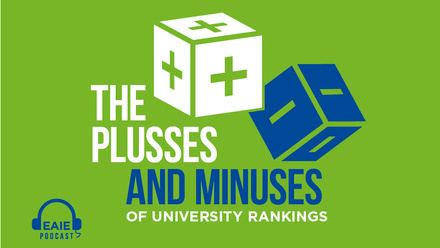10 reasons why rankings matter in higher education

University leadership and policy wonks excitedly await the results of yearly university rankings. Part of the excitement is waning, however, due to the same (old) institutions being listed every year. In the EAIE Barometer study, 35% of practitioners indicated that improving international reputation or position in rankings is one of the top three reasons for internationalising. Rankings are used by some governments in their higher education policy, by institutions looking for international partners and by prospective students searching for a place to study – due, often, to the lack of other widespread metrics. But how powerful are rankings in the higher education world?
-
National policy
The study Rankings in institutional strategies and processes (RISP): Impact or illusion? upholds that many governments use rankings to provide funding for selected institutions deemed as capable of becoming world-class, whereas others make use of rankings for classification purposes. In recent years countries as diverse as India, the Russian Federation and the Netherlands have made use of rankings in their partnership schemes, recognition and immigration policies.
-
Institutional decision making
According to the majority of the respondents of the same RISP survey, rankings affect institutional decision making. In it, 27 percent of respondents report that policies have been revised, 26 percent report that focus has shifted to new features of existing procedures, while 23 percent indicate that changes have taken place in the research areas prioritised and 21 percent that the criteria for recruitment and promotion have been affected.
-
Monitoring and benchmarking
The vast majority of RISP survey respondents report that they monitor their institutional performance in rankings and that the senior institutional leadership is involved in this process. Some even have dedicated staff or units for this purpose. Many use rankings not only to monitor their own performance, but also that of their partners and competitors for benchmarking purposes.
-
Data collection
A briefing paper from the Institute of Higher Education Policy states that, in practice, rankings impact discussions about, and collection of, comparative data on both a national and institutional level. Rankings encourage not only the collection but also the publication of education data – according to the Global university rankings and their impact study.
-
Partnering
Most research in the field indicates that rankings impact institutional partnering. This applies particularly to international partnering, as knowledge of (prospective) partner institutions is often not sufficiently available. Having a highly ranked partner can also be used for reputational purposes.
-
Branding
The Trends in Higher Education Marketing, Recruitment, and Technology study shows that university branding requires constant effort and data to support a desired image. A university’s position in rankings serves this purpose well. Ranking outcomes are often mentioned on institutional websites, on social media and institutional presentations in order to increase institutional visibility and credibility.
-
Student choice
The Effects of Rankings on Student Choices and Institutional Selection study outlines how rankings affect the choice of study destination, particularly when studying internationally. Especially as, in such cases, information about institutions and education system in the direct network of prospective students is often limited.
-
Quality of enrolled students
The same study purports that the quality of the students enrolled correlates with how well a university performs in rankings. That is, students with good academic records prefer to enrol at highly ranked institutions perceived as offering better education – or, at the very least, a more impressive diploma.
-
Attracting researchers
Researchers tend to seek to employment at institutions that are perceived as prestigious in their field. Respondents of the RISP survey believed that rankings influence prospective researchers. This was particularly perceived to be the case for internationally-ranked institutions.
-
Research choices
Due the indicators used, rankings reportedly affect research choices in three different ways: the language of publication, with an increased preference for English; publishing on matters of international interest; and prioritising publishing in specific journals.
In sum, rankings influence our view of academia and prestige and therefore affect institutional and personal decision-making – as well as policies and practices. Many argue that this is not due to their merit, but rather due to the lack of other comparative international data on the same scale. The influence rankings have varies, however. It is dependent on the type of higher education institution, the higher education system it is located in, and the availability of other information.
Anna-Malin is Policy Officer at the EAIE






